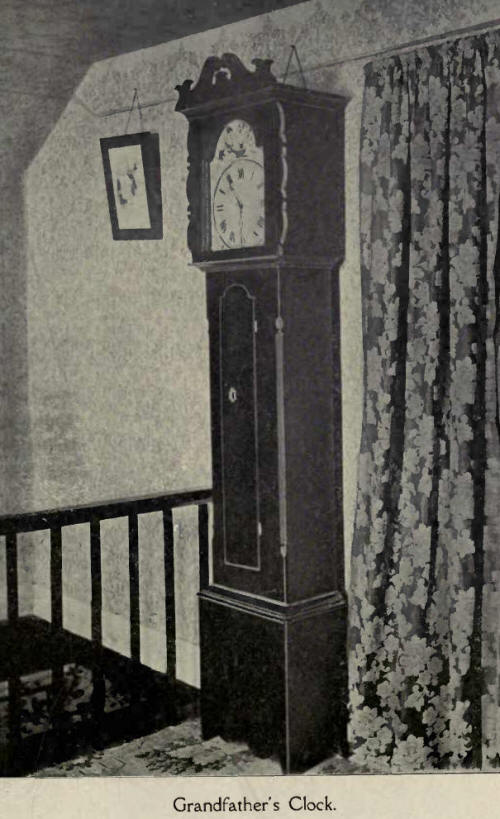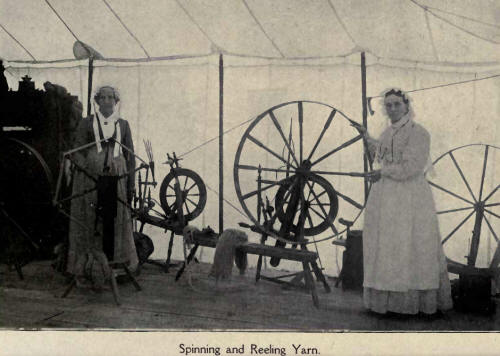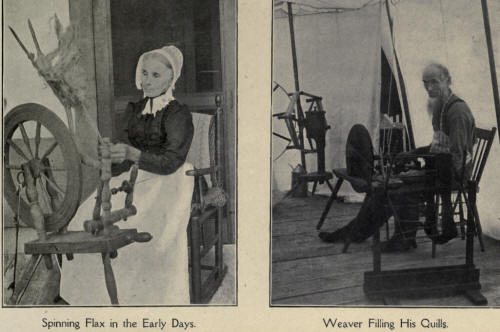|
THE FIRST STOVES—THE
OLD CORNER CUPBOARD—THE GRANDFATHER'S CLOCK—THE
OLD FLINT-LOCK MUSKET—THE DINNER HORN—THE OLD DASH CHURN.
THE first
settlers did all their cooking and
warmed their houses by means of fire-places.
Until chimneys were built, they
were obliged in some cases to let the
smoke escape by a hole in the roof. A pole was
run up
from the ground through this hole, and it is said the
smoke would circle around it, and so find its
way out.
It was necessary, of course, to keep a door or window
open in order to get a draught. It was not
until about
seventy or eighty years ago that cooking stoves first
came into use, and since then their use has
changed
things considerably, and so have the stoves, too, in
style
and shape. It was some time after their introduction,
however, before their use became universal, as
even
fifty years ago many of the farmers in the country still
did all their cooking in the old fireplaces.
Among the
first styles of cooking stoves in Upper Canada were
the
old "King" stove, with its elevated oven, the hollow
place underneath the back part of the stove being usually kept filled with
kindling and other wood to keep it dry, the "Burr" and "Davy Crockett,"
all familiar to many of the old folks, and reminders of the happy days
gone by. Big heavy box stoves, for heating purposes, were introduced at
the beginning of the century, but being expensive, the families who owned
them were few and far between, some could not afford them, and others were
slow in taking up with newfangled ideas. One of these old stoves is still
in the possession of the family of a descendant of one of the old
pioneers. It has been in constant use since before the War of 1812-14. The
writer's great-grandmother, being afraid that someone might steal or
destroy it at a time during the war when she fled with her children for
safety back into the country, had it sunk in the creek at the back of the
farm, where it lay all one winter. To this day it carries the marks of
that bath, for the rust ate into its surface, although not enough to
destroy the figures. It is a two-storey box stove, made of cast-iron
plates, so arranged that it can be taken apart in the summer time and laid
away.
In the homes of a few of the
well-to-do families was to be seen years ago the "Franklin" stove, said to
be the invention of Benjamin Franklin. It was, in the way of heating,
perhaps, the first remove from the fireplace, which it was certainly an
improvement upon, as it had a stovepipe attached, and so prevented a great
deal of the heat of the fire from passing up. the chimney., a fault with
the old fireplace. . It had, like the fireplace, however, an open front
with fire-dogs. After a while folks saw that by closing the front the fire
burned just as well, and better; this fact led to the invention of the box
stove, and later on the cooking stove.

Most of us, who have always been
accustomed to modern conveniences, can hardly imagine just what the
simple, primitive life of our forefather was like. Life in the backwoods
to-day is different to what it was in the early days of settlement.
The Old Corner Cupboard.

In a corner of the dining or
sitting-room was generally to be found the old corner cupboard, with its
glass doors; behind which were placed the porcelain, china and glassware,
the dishes covered with blue or red-colored pictures of Chinese pagodas,
of landscapes, of men, women, animals and birds. The plates were usually
set on edge around the sides of the cupboard and the nested cups and
saucers in the centre. Below the dishes were several drawers for keeping
the knives, forks and spoons in. In the bottom part of the cupboard,
behind wooden doors, were usually kept handy such articles of food as
bread, butter, sauce, a jug of milk, etc. When the children, after romping
in the orchard, around the barn and stables and over the farm, came in
tired and hungry, their kind-hearted aunt would go to the corner cupboard
and spread them a thick slice of bread and butter, with a good liberal
coating of apple sauce or "schmier kase," or perhaps give them a bowl of
bread and milk. How very good things tasted when taken out of that old
corner cupboard, with the appetite whetted by the active exercise of
youth! What epicurean dish could be manufactured to give equal enjoyment?
The Grandfather's Clock.

In another prominent corner of one
of the living rooms usually stood the grandfather's clock. Mostly it hung
on the wall, with the weights by which it was wound dangling in the air;
or perhaps the works were fittingly enclosed in a suitable case. With its
flowered dial, highly polished case and large pendulum, it was quite an
imposing piece of furniture, and the sound it made as it struck the hours
solemnly broke the stillness of the midnight air. With descendants of some
of the old families may still be found one of these old clocks that has
come down to them after a couple of hundred years Generations come and go,
but still the Old clock wags on, a monument of bygone days. What a pleas-
ant reminder of the old song:
My grandfather's clock was too
long for the shelf,
So it stood ninety years on the floor
It was
taller by half than the old man himself,
Though it weighed not a
pennyweight more,"
How interested we were in seeing
grandfather wind up the clock! When there was no one around, we would
sometimes stealthily open the door and peer curiously in at the works. In
many of the old clocks the wheels were made of wood, and not a few of the
more expensive kind had music boxes attached, which served to make them
still more attractive. In the early days peddlars (usually Yankees) went
around among the people introducing these clocks. After buying one, the
farmer would engage a carpenter to make a case for it. Occasionally thee
would be found a house among the poorer class of settlers in which there
was no clock, the time being told by the sunlight reaching a certain mark
on the floor. On cloudy days the time for getting dinner had to be
guessed. Sun-dials were also introduced and did the duty in some of the
houses of indicating the time.

The Old Flint-Lock Musket.
The only gun in use, by the military as well as the
people, seventy-five years ago or more was the old flintlock musket.
Breech-loading firearms were unknown. Even still, among the descendants of
some of the old settlers, are to be found some of these old guns that did
service perhaps in the War of 1812-14 and the Rebellion of 1837-38, handed
down as family heirlooms.
In the hammer of the flint-lock gun was fixed a piece
of flint, which struck a piece of steel near the flash-pan when the
trigger was pulled. This threw up the cover of the pan, flashed a spark
into it, and so ignited the powder. If the gun had not been loaded so as
to properly fill the vent hole which connected the flash- pan and the
barrel with powder, there would be a "flash in the pan" but no discharge.
The clumsy old horse pistols were made on the same principle as the guns,
there being no revolvers then.
Sometimes it was difficult to get these old
flint-lock guns to go off. If the powder happened to get the least bit
damp it would not ignite. For this reason it was necessary to protect the
gun from the wet, so as to have it in readiness. It is said the
expression, "Trust in God and keep your powder dry," was first made use of
by a certain general in the army many years ago, in the days of the
flint-lock gun, when addressing his men previous to an engagement. After
the heavy and cumbersome flint-lock gun came the gun
with the percussion pill lock. A small percussion pill was placed over the
vent hole of the gun perhaps smeared over with a little tallow to keep it
in place and free from moisture when the gun was ready for being
discharged. After the percussion pill came the percussion cap lock. Small
copper percussion caps were placed on a nipple through which the vent hole
passed.
The percussion lock was an
improvement and more convenient in every way than the flint lock, for it
did not require "priming," i.e., putting powder into the flash-pan when
loading. The percussion lock was also a "muzzle loader," i.e., the
ammunition had to be put into the end of the barrel and pounded down with
the ramrod carried in connection with the gun. It was loaded as follows:
first the powder was poured in, then a piece of wadding (generally tow,
although paper was sometimes used), was well rammed down, so that it would
be sure to fill the vent hole with the powder. On this was poured the
shot, after which another piece of wadding was shoved in to keep it down.
If not properly loaded the gun was
liable to burst and injure the marksman, perhaps blow off a hand or an
arm, or even fatally wound him. Accidents of this kind happened
occasionally. The old-fashioned flint-lock gun served both as a shot-gun
and rifle, shot being used for killing wild fowl and small animals and
bullets for larger game. Nowadays we have rifles with a special bore in
the barrel for bullets only, as well as guns for shot. Hunting was a
favorite pastime among the young men in the early days, many of them being
"good shots." When not in use the old gun stood in the corner, or hung on
the wall over the door, or against the chimney above the fireplace, where
it was kept free from rust, besides being out of reach of the children. In
the pioneer times it was used to kill bears, wolves and other wild
animals, also crows, hawks, pigeons, etc., which were so plentiful that
they were pests to the farmer, often doing considerable damage to his
crops, and not infrequently it served as a protection against marauding
bands of Indians. The hunter always carried a powder horn attached to a
string slung around his body. In addition to this he carried a bullet or
shot pouch fastened to his belt. His bullets he made by pouring melted
lead into moulds of different sizes kept for the purpose. Soldiers carried
cartridges in their pouches. When loading, they bit off the end of the
cartridge, poured a little of the powder out of the cartridge into the
flash-pan, and the remainder into the barrel after which the paper wrapper
and the bullet which was fastened to one end of the cartridge were shoved
down with the ramrod.
The Dinner Horn.
At most of the farmers' houses a
tin horn several feet long was kept for calling the men from their work in
the fields, woods and barn to their meals. If there was no horn many of
them would hang a white cloth on a pole where the men could see it. Often
the hollow tinkle of an old cow-bell served the purpose and might be heard
hoarsely reverberating over the fields and clearings. Sometimes, an old
worn-out cross-cut saw, a big steel triangle, or the used-up mould board
of a plough were hung up to a tree and hammered on, to notify the workers
that dinner was ready.
One of the writer's
great-grandfathers had a horn made of a sea-shell, a conch, which is still
in use in the family. Later on, some of the farmers had a bell placed on
the roof of the house to call the men in from their work. Its melodious
tones were never an unwelcome sound to the weary worker as he toiled in
the harvest field, in the logging field, or at the plough. It announced a
glad respite from labor, and the hungry laborer went towards the house
with an appetite for dinner few city people know anything about. To a
really hungry man everything tastes good; he does not have to pamper his
appetite with this and that dainty condiment, in order to be able to eat
enough to properly nourish his body.

It is said that even the horses
well knew the sound of the dinner bell and would sometimes stop in the
middle of the furrow and refuse to go any further until after they were
fed.
The Old Dash Churn.
The first churn in use was the old dash churn. It has
not as yet been altogether superseded, although newer styles, that are
much easier to operate, have to a very large extent taken its place. It is
doubtful, however, whether any of the new-fangled kinds make the butter
taste any sweeter and richer than that made in the old- fashioned way.
Possibly this was because of the labor required to produce it. How
patiently did the women, with their capacious calico or linen aprons tied
around them, stand beside the old-fashioned churn, and stomp away at the
cream until the oily globules were gathered into a mass of golden butter.
The first indications that the butter was coming was
the heavy sound the cream made as it thickened, and the ring of butter
which gathered around the hole in the cover through which the handle of
the dasher passed. When the cover was raised, to see how the churning was
progressing, you could see the dasher and sides of the churn covered with
cream and flecked with little pieces of butter. Sometimes hot water was
poured into the churn to raise the temperature and make the butter come
more speedily. When the cover was removed for the last time and the butter
taken out with the big wooden ladle, the children could be seen gathering
round with CUPS for a refreshing drink of buttermilk.
When the women were too busy to attend to all the
dairy matters themselves, they would place a big apron around one of the
small boys or girls, stand them on a stool and get them to do the
churning. This was labor to us children, and the time would drag wearily
until aunt came, examined the milk, and pronounced the churning finished.
Our weariness was soon dispelled, however, by a thick slice of fresh bread
and butter.
So much for such homely work and its rewards, which,
perhaps, the critical reader may not consider worthy the time bestowed
upon describing. But it must be recorded, as we have undertaken to be the
faithful chroniclers of the times and of the doings and manners of the
people of whom we write, the early pioneers of Canada.

|

